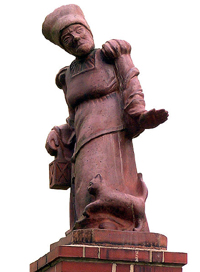
STADT BENSHEIM (GERMAN) 50 PFENNIG 1917
L- 34.4 City of Bensheim (Hessen) Zinc 50 Pfennig Coin Depicting Knight Holding Lance and Shield, Dragon
This iron coin depicting a knight and a dragon was issued by the City of Bensheim and was meant to be used as small change. The imagery may be a variation on the city crest which shows the well worn theme of Saint George on horse back slaying a dragon. Saint George is said to have been the towns patron saint in the past. It may also be a depiction of the legendary knight Basinus who is said to have been the towns founder. The earliest mention of Basinsheim was in the Lorsch Abbey’s Codex Laureshamensis, written between 778-820, under the rule of Charlemagne. Right: Statue of Fraa vun Bensem (woman from Bensheim) |
 |
As the story goes, the knight Basinus was given the right to found a settlement in the area by the Lorsch Abby to settle a dispute and avoid conflict with the knight. Town rights were granted by Emperor Otto I on March 5th 956 during his stay in Frankfurt am Main giving Bensheim market rights. Much of the town was destroyed during a siege in 1301 by King Albrecht I, founder of the House of Habsburg. Bensheim then became a part of the Electorate of Mainz’s domains.
Pledging to the counts palatine of the Rhine, a part of the Holy Roman Empire, Bensheim grew and it become a thriving market town. It also suffered from the consequences of imperial politics. During the Bavarian-Palatine war of succession in 1504, Bensheim was besieged for eleven days by the Landgrave of Hesse.
On November 20, 1644, Bensheim was occupied by French and Swedish troops. This occupation lasted only days as they were driven out by Bavarian units on December 2nd. This gave rise to the legend of the Fraa vun Bensem (woman from Bensheim) who is said to have led the Bavarians into town through a secret route.
The Reichsdeputationshauptschluss was a reorganization of German states and in 1803, Bensheim passed to the Landgrave of Hesse-Darmstadt, who then joined the Confederation of the Rhine in 1806 and raised to Grand Duke. In 1832 reorganization created the district of Bensheim (Kreis Bensheim) with the City of Bensheim as its seat.
This coin was minted late in World War I. At this time, Bensheim was still a part of the Duchy of Hesse-Darmstadt and a part of the German Empire. The coin states that it is 'Kriegsmunze' which means War Money. Just a year later the war would end, the German Empire was dismantled, and its monarchies were overthrown as a result of the German Revolution of 1918-19.
Ernest Louis was the last Duke of Hesse-Darmstadt. He was asked to abdicate but refused. His abdication was not required, his title was simply abolished and his official power revoked with the proclamation of a republic. The state was renamed the Volksstaat Hessen (People's State of Hesse). This is not to be confused with a socialist state, it was merely a title that boldly states rule by the people and not a monarch. During this change Bensheim district was dissolved and Bensheim the town was no longer a district seat. It was, however, later made a district headquarters of the Nazi Party.
During Kristallnacht on November 9, 1938, the synagogue was destroyed. By WW II there was a concentration camp in Auerbach (part of Bensheim). By the end of the war, the town had been partly destroyed by bombing and it passed to the newly formed state of Hesse.
The town lies at the eastern edge of the Rhine rift on the slopes of the western Odenwald mountain range. Bensheim is especially well known for its mild and sunny climate making its surrounding areas perfect for cultivation of grapes for wine. Kiwifruit, almonds, figs and peaches also thrive here, giving the area the nickname “Germany’s Riviera.”
